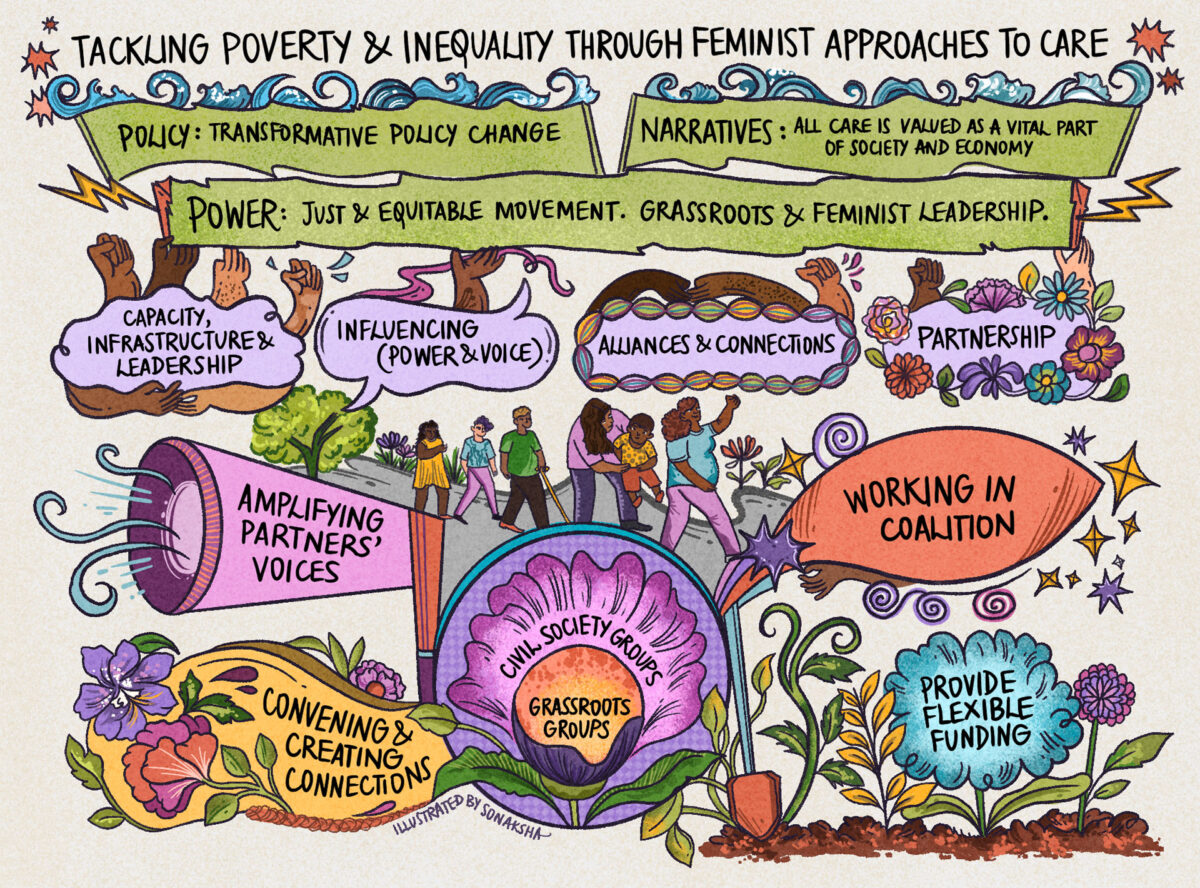How should INGOs share power to work with others – and especially grassroots and community groups – to achieve a feminist economy that values all care work? Ridhi Kalaria and Silvia Galandini share insights from Oxfam’s influencing across the UK; from backing existing movements and investing in long-term change, to knowing when to step back. Illustrations by Sonaksha Iyengar.
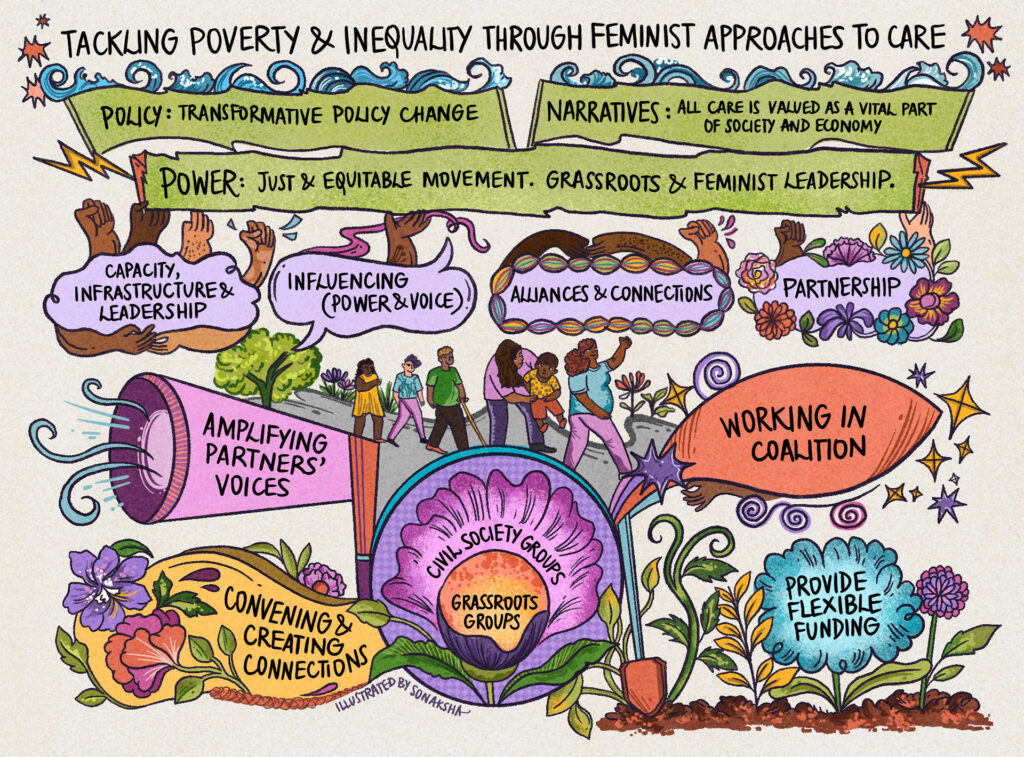
At the heart of Oxfam’s UK work on valuing all forms of care to tackle poverty and inequality is a bold vision: a fundamental shift towards a feminist caring economy. One where policies, narratives, and practices prioritise caring for people and the planet, above wealth accumulation and extraction.
A feminist caring economy is one where:
- Those caring unpaid for children and for disabled, ill and older people are valued and supported
- Childcare and social care workers are fairly paid and rewarded
- Care services are invested in as vital infrastructure
- Unpaid carers, parents and paid care workers have equal power to shape decisions that affect them
To move towards this vision, as a large INGO, we’ve addressed how we work with others. That’s meant stepping back, listening deeply to those already driving change – including carers and groups focussed on workers’ rights, anti-poverty, gender, disability and racial equality groups and movements – and showing up differently for them and in collective spaces.
Grassroots groups1 – especially those pursuing social justice and led by communities impacted by inequalities based on gender, race, disability and other identities – often face deep-rooted barriers to power: exclusion from decision-making, limited funding and infrastructure, minimal support to build capacity, and too few places to connect in solidarity.
We’re sharing six key areas of change that INGOs should prioritise to shift and share power – especially with grassroots movements that are already pushing to break the link between care, poverty and inequalities.
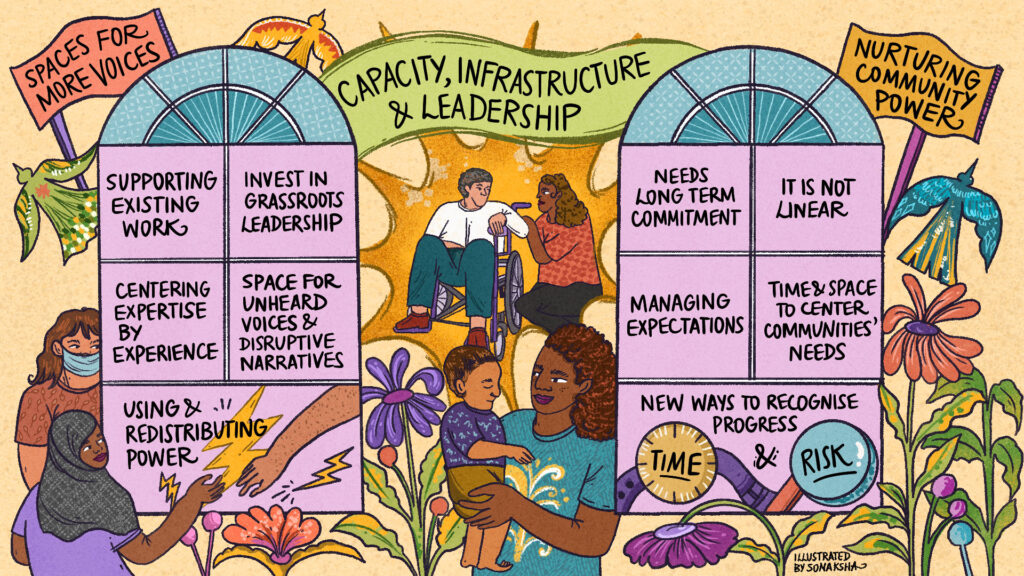
1. Back existing movements and trust them to set priorities
Start by asking “who is already driving change?”, then listen to them. This enabled us to support work that was already underway, and often under-resourced. Sometimes support looks like small grants to fund specific initiatives, or core costs for partners – especially grassroots organisations – to build infrastructure, think about future strategy, and access training. Sometimes it is about building connections or providing a sounding board.
All this has meant using our power with, not over; shifting from “what do we want to achieve?” to “how can we support what’s already being built?” Partners are trusted to define their own priorities and success, working with the communities they represent.
It has also meant going beyond networks we already know, to reach and include more people and organisations, less obvious voices and ideas, and ultimately invest in grassroots leadership.
2. Be flexible, rethink measures of success and invest for the long term
If we want community and grassroots power to truly drive change on valuing all care work, we must focus on making long-term commitments. This work takes time – time to build and sustain confidence, nurture collective voices through the ups and downs of making change happen, and deeply understand what communities need and hope to achieve.
If the goal is to shift power, it’s key to invest in social movements — not just projects and one-off campaigns. That means funding people and their power — not just outputs.
We also need to rethink how we define and measure the “success” of such funding. We need to go beyond more traditional measures and appreciate the value of broader ‘signs of change’ like new connections, strengthened structure and time to support wellbeing amongst others. We also need to embrace drawbacks and setbacks as part of the social change process and not see these as failures.
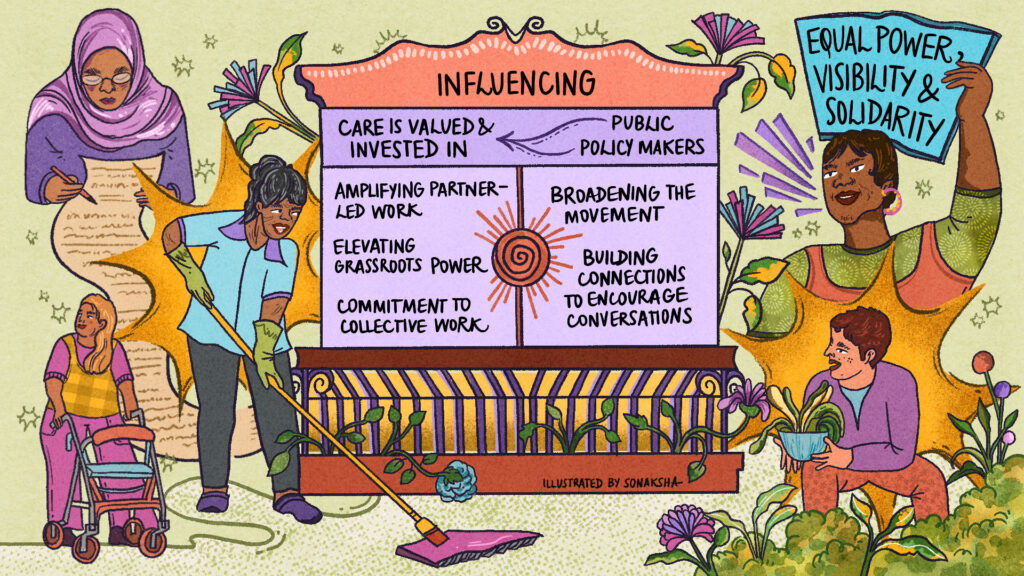
3. Trust is vital, as is knowing when to step back
Our support around partner-led influencing has often involved stepping back. We supported where we were asked to, not where we thought we ought to.
Supporting partner-led influencing isn’t a one-off project; it’s about building an ongoing relationship based on trust. It takes time and demands stability. The partnership needs to be consciously modelled and should challenge existing organisational hierarchies. Otherwise, we risk reinforcing the same power imbalances we’re trying to dismantle. Without this commitment, collective efforts begin to unravel — there is a loss of momentum, uncertainty grows, and hard-won progress risks slipping backwards.
4. We can and should work at many levels, combining broad policy influencing with equitable partnership work
Our vision for change is broad: all care has to be valued. To achieve this, our work and partnerships span diverse policy areas, issues, and conversations across many spaces and networks.
Combining broader influencing work with connecting with specific communities and grassroots is complementary: we have space to bring the people and groups we work with together to think about the wider changes we need to challenge existing norms and narratives, and to unlock more ambitious policy change.
Where specific policy change is needed – realistic, achievable and incremental – Oxfam has used its power and visibility to push for this: always looking to amplify and join in solidarity with those whose expertise and knowledge lead the way.
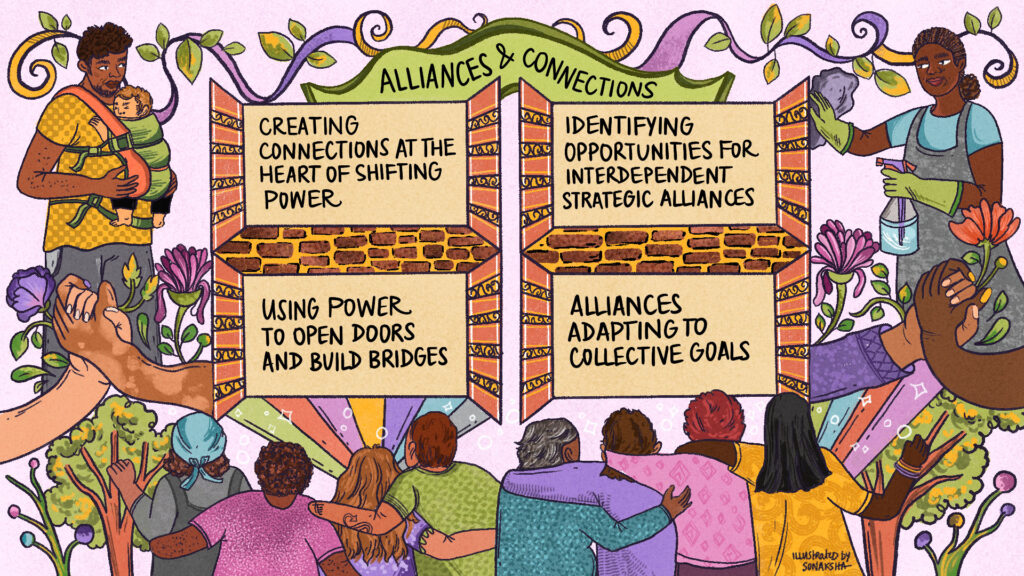
5. Cultivating connections is at the heart of shifting power
Intentionally investing energy in cultivating connections between people and organisations is at the core of shifting attention away from our own exclusive vision, plans and strategies, and towards thinking about who is already driving change and what they need to be supported and amplified.
Leveraging our presence as an INGO, we’ve spent time linking those who wouldn’t necessarily have met or worked together. For example, introducing grassroots groups to larger organisations and decision-makers.
More work is needed to build a more connected movement on valuing all care – as others have also observed. Our work has taught us that it’s important to find the right balance between nurturing a broad vision for change – a useful backdrop to bring ideas, efforts, people and organisations together – and pushing for targeted policy change, adapting alliances to the shared goals.
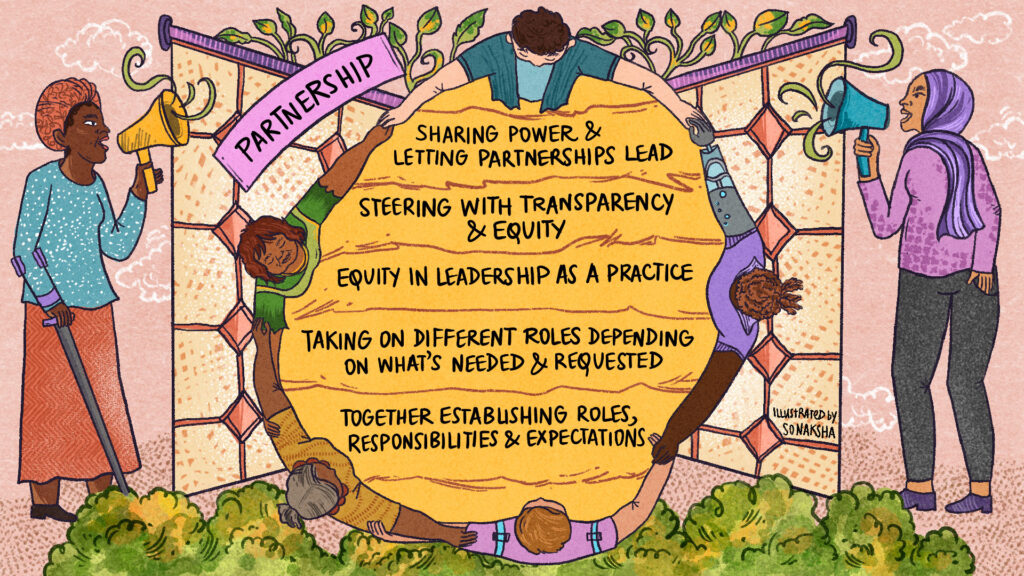
6. Equity is about the relationships we hold and power we share
We’ve learnt that equity in leadership is first and foremost about letting partners lead and sharing our power to elevate the agendas of those we are working with. This acknowledges everyone’s contribution and expertise.
We’ve come to appreciate how this equitable leadership is a key part of the role that everyone plays in building alliances, not simply a job title or position in organisational structures. And this also means being ready to play different roles aligning with what partners need from us – our input might be about providing expert knowledge or creating connections, but also more ‘hands-on’, like planning and coordinating work: all these functions are equally important if we want to achieve our shared goals.
We have also learnt how important it is that internal processes and ways of working – especially around grant-making, e.g. due diligence, reporting, timelines – are not focused on ‘assessing’ partners, and instead on establishing together the terms and values underpinning our partnership. This has meant shifting entrenched practices and norms – and we’re very much still working on it. But it’s fundamental to truly change power imbalances.
Similarly, we’ve come to appreciate that open and honest conversations that establish roles, responsibilities, and expectations are essential — without becoming too rigid. Because clarity doesn’t block equity. It enables it.
The journey continues…
We must challenge ourselves to put our values into practice. There will always be trade-offs and tensions, and we won’t always get it right. But we’ll continue to try, learn and adapt – as we know that the practice of equity is very much at the heart of building a feminist caring economy.
We would like to thank Liz Griffin at Hidden Depths Research for her support with gathering the learning from this work; Sonaksha Iyengar for bringing the learning to life through the illustrations; and all the partners that have given their time to share their reflections on their own and our collective work.
- We define grassroots groups and movements as those that are rooted in and accountable to the community they represent, whether this is a local area or a particular group affected by injustice. ↩︎
